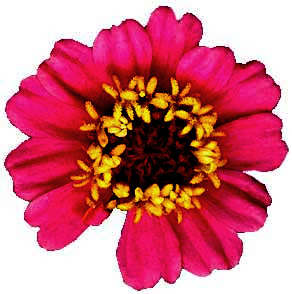
When in 1519 Spanish conquistadors marched into Mexico City, then known as Tenochtitlan, the highly civilized Aztec Indians living there were growing zinnias in their gardens. Most of today's many zinnia varieties and hybrid strains are derived from three wild zinnia species, all from Mexico. About 17 zinnia species are recognized, genus Zinnia, all native to the Americas. The one at the right is Zinnia angustifolia.
Zinnias are members of the huge Composite or Aster Family, so their blossoms are very unlike those of most flowers, whose basic structure is described on our Standard Blossom page. Our special page on Composite Flowers outlines basic composite-flower structure. Using composite-flower concepts, then, the above picture shows a zinnia flowering head, or "capitulum." The head's center is occupied by numerous disc florets with cylindrical corollas with yellow lobes, while the head's margin bears ray florets with long, flat, dark-pink corollas looking like a typical flower's petals.
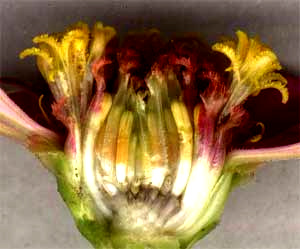
At the left, a zinnia flowering head is broken open to reveal yellow disc florets, each with five corolla lobes, in the head's center. Along the head's margins, ray florets bear pinkish, flat corollas expanding outwards. Notice that the florets arise from atop a conical to cylindrical receptacle -- the receptacle being the white hump at the center in the bottom part of the picture, pitted like a golf ball's surface. In many Composite Family species, the receptacle is flat or very low-humped.
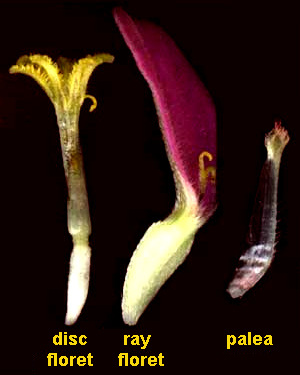
If you look very closely and halfway know what you're seeking, you can see that each floret has beside it a pinkish, fuzz-tipped scale known as a "palea," or chaff. In the big Composite Family, many species have no paleae, so during the identification process, their presence or absence is an important feature to note. At the right, individual male and female florets, and a palea are shown.
Another identification feature for Zinnias, at least for the cultivated forms, is that at the top of the immature fruits there is no pappus -- no hairs that later will become the "parachute" atop the seed, and no spines that later will help the seed stick to animal fur. The ovaries of some wild species do have 1-4 short tooth-like scales or awns.
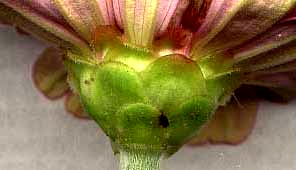
At the bottom of each zinnia flowering head there's a scaly involucre such as that shown at the left. The large scales are known as phyllaries and they come in many sizes, shapes and configurations. Phyllaries are another important detail to notice during the identification process. Zinnia phyllaries are generally broad with roundish tips, overlap one another instead of growing together at their margins as with marigolds, and are arranged in 3-4 series.
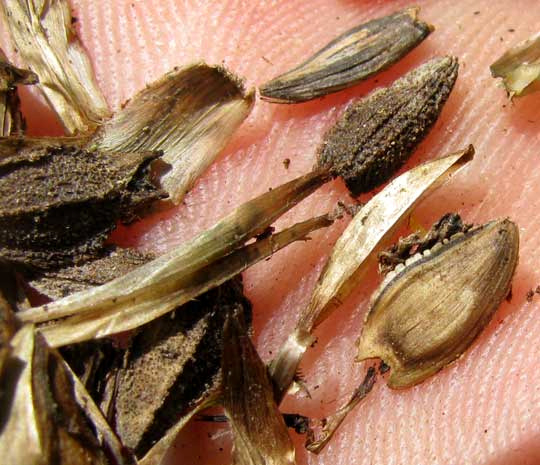
Ovaries at the bottom of each floret mature into a special one-seeded, dry fruit that doesn't split open at maturity, called a cypsela. When we plant zinnia "seeds" in our gardens, we're planting cypselae. The picture shows part of a matured, dried-up zinnia flowering head crumbled apart, to show the oval cypselae and some dry paleae.